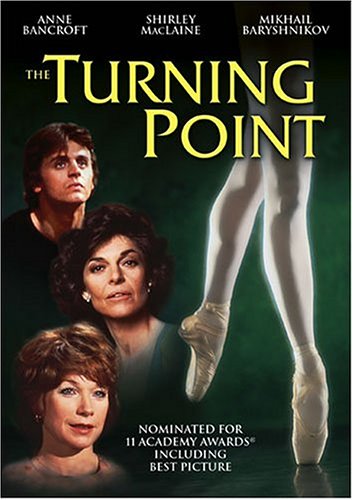Did Gelsey Kirkland Make Herself Sick to Avoid Starring in The Turning Point?
Here is the latest in a series of examinations into urban legends related to dancing and dancers and whether they are true or false. Click here to view an archive of the dancing urban legends featured so far.
DANCING URBAN LEGEND: Gelsey Kirkland made herself intentionally sick so that she would not be able to do the film The Turning Point.
Gelsey Kirkland has led a rather tumultuous life as one of the most famous American ballerinas in history.
She joined the New York City Ballet under famed choreographer George Balanchine in 1968 when she was only 15 years old. By 1969, she was a soloist and by 1972 she was principal.

Later in the decade she joined famed ballet dancer Mikhail Baryshnikov at the American Ballet Theater, where they performed probably her most famous role, opposite Baryshnikov in the 1977 televised performance of The Nutcracker…

Later, she even made the cover of Time magazine in 1978 for her performance in Swan Lake. Kirkland was a star.

Hollywood did not fail to notice the buzz that was surrounding the American Ballet Theatre during the mid-to-late 1970s, so in 1976, Arthur Laurents (who certainly had no lack of experience with the world of theater and dancing, having written the book for the classic Broadway musicals West Side Story and Gyspy) wrote the script for the film The Turning Point, with the movie centering upon two old friends, one (Shirley MacLaine) who gave up ballet stardom to raise a family and the other (Anne Bancroft) who went on to become a prima ballerina. Now Bancroft is offering MacLaine’s daughter a position in her ballet company. The reunion brings back old memories for the two friends, both good and bad.

The ballet company in the movie is made up of American Ballet Theatre stars, including Baryshnikov (the director of the film, Herbert Ross, also choreographed for the ABT). MacLaine’s daughter was to be played by Kirkland.
However, Kirkland was removed from the film because of health problems. At five foot four inches, Kirkland was only 80 pounds! In addition, she was suffering severe potassium deficiency.
Kirkland was replaced by her understudy, Leslie Browne, who went on to receive a nomination for an Academy Award for her performance in the film. Here is Director Ross lifting Browne (with Baryshnikov in the background)…

Okay, so the question at hand here revolves around Kirkland’s intent at the time. In her auto-biography, Kirkland stated that she made herself sick so that she would not have to do the film. Do we believe her?
Well, there is a problem with – mostly because if you read Kirkland’s biographies, she’s pretty much unwilling to take any blame for anything that went wrong in her life, laying the blame at first Balanchine, then Baryshnikov and, in the case of The Turning Point, her desire to have no dealings with Hollywood.
So when she says that it was her decision to make herself sick, should we believe her?
It’s extremely difficult to discern motive like this, but I tend to agree with her, basically because while she was already anorexic, her bulimia surfaced when the movie began casting – she dropped from the mid-90s in weight to the low-80s in a very short span of time. Then, after the film was filmed, she recovered from her bulimia.
Remember, her greatest performances were all AFTER the filming of The Turning Point, when she was in her mid-20s. Heck, her most famous performance was in 1977 (the aforementioned Nutcracker), which was the same year that the film came out!
Also note that Browne, the woman who replaced her in the film, ALSO ended up turning down multiple film roles after the filming of The Turning Point.
I think there’s something to be said for the fact that these women’s personalities did not lend themselves to pursuing film stardom. Heck, Browne was VERY vocal about not wanting a film career, yet she took acting and singing classes for awhile after The Turning Point. Almost certainly it is because that was what was expected of her – and that surely seems to be the same case for Kirkland – she was told she should do the movie, so she tried out for the movie, but her form of silent protest was to make herself so skeletal that they couldn’t possibly cast her.
As the decade went on, while Kirkland beat her bulimia, her addiction to cocaine (which also began aroudn the same time) worsened, and by the beginning of the 1980s, she was replaced at the ABT, as she just was too unreliable. She officially left the ABT in 1984. She eventually overcame her drug addiction during the 80s, and spent a number of notable years performing ballet in Britain before retiring from active dancing.
She has been a highly-sought out ballet teacher ever since.
In the end, it is obviously very difficult to tell what is “self-destructive behavior” (bulimia and cocaine addiction) and what is “intentional self-destructive behavior” (forced weight loss through vomiting), but for now, at least, I’ll give Kirkland the benefit of the doubt – it’s not like “I intentionally made myself dangerously sick so that I wouldn’t have to do a movie” is exactly behavior to be PROUD of, after all.
The legend is…
STATUS: I’m Going With True
Feel free (heck, I implore you!) to write in with your suggestions for future installments! My e-mail address is bcronin@legendsrevealed.com.





